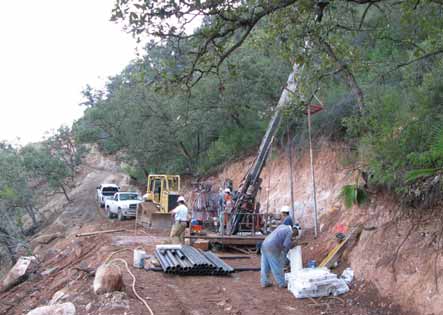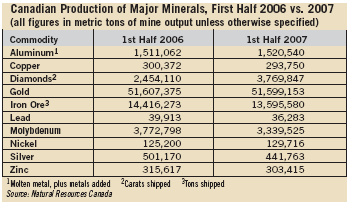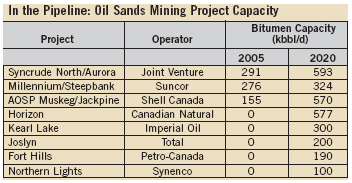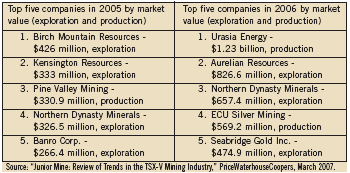By any commonly accepted unit of measurement,
Canada is a mining powerhouse,
with a strong domestic industry and a hefty
global share of mineral exports, international
exploration activity and mining technology
transfer. Canadian mines produce
60 commodities—ranking the nation
among the top 10 global producers for 17
of them—and 60% of all mineral exploration
companies are listed in Canada. It’s
also estimated that about 50% of all mining-
related equity financing takes place
there as well.
Canadian mineral production, including
coal, was valued at $33.6 billion in 2006,
almost 23% higher than the $27.4 billion
reported in 2005. The bulk of the increase
came from metallic mineral production,
which reached $21.2 billion in 2006, an
increase of 45.4% over 2005. The value of
Canadian nickel and copper production, in
particular, rose by a whopping 75.9% and
78.8% respectively, due to rising metal
prices, although the actual increase in production
volume for these two metals was a
modest 17% and 3.1%, respectively. Iron
ore production rose by 12.2% in volume
and 10.5% in value during 2006, while
gold production dropped by 13.5%
although its value gained 8.4% to more
than $2.2 billion.
2007 is on track to be another very
good year for the Canadian industry,
although statistics for the first half indicate
that mine production of some major metals
is running slightly below that of the same
period in 2006.
However, the industry’s record pace in
2006 as well as this year-to-date’s mild
falloff have been overshadowed by two
other factors: the increasing importance
of junior companies in the endless search
for economically recoverable mineral
deposits; and a wave of M&A activity that
resulted in changes of ownership for a
handful of premier Canadian mining and
metals companies, mostly to non-
Canadian entities. Starting in 2006, this
includes:
• Falconbridge Ltd. acquired by Xstrata
plc for $18.2 billion in August.
• Inco Ltd. acquired by CVRD for $18 billion
in November.
• Placer Dome acquired by Barrick Gold
for $10.25 billion in March.
• Also in 2006, Canadian steel producer
Dofasco was bought by Arcelor SA for
$5.3 billion; but in a reversal of the
trend, Canadian producer Goldcorp. Inc.
acquired Glamis Gold, a U.S. company,
for $8.7 billion.
• 2007 began with Ontario-based Kinross
Gold acquiring Vancouver’s Bema Gold
Corp. in late February for $3.1 billion.
More recently, as reported in E&MJ, Rio
Tinto announced on July 12 that it would
buy Canadian aluminum producer Alcan
for $38.1 billion, pending regulatory
approvals.
• In August, U.S. Steel announced it
planned to acquire Stelco of Canada for
$1.1 billion to gain processing capacity
for its excess iron ore. In addition to its
mill assets, Stelco, through its HLE
Mining subsidiary, holds minority ownerships
in several iron ore mines. These
include:
• Hibbing Taconite Co. (14.7%)–Based
in Hibbing, Minnesota, USA, Hibbing
Taconite has total iron taconite
reserves estimated at 158 million
tons of product with an expected
mine life of 19 years. Hibbing’s
rated production capacity amounts to
8.1 million t/y of pellets, of which 1.2
million tons go to Stelco.
• Tilden Mining Co. (15%)–Based in Ishpeming,
Michigan, USA, Tilden produces
from a complex ore body of
hematite ore (35% iron) and magnetite
(24% iron). Total reserves are
estimated at 265 million pellet tons
with an expected mine life of 34 years.
Tilden’s capacity is 7.8 million t/y, of
which Stelco takes delivery of about
1.2 million tons of iron ore pellets.
• Wabush Mines (44.6%)–With mining
operations in Wabush, Labrador, Canada,
and Pointe Noire, Quebec, this
joint-venture company has total reserves
of hematite iron ore estimated
at 51 million tons. Wabush has a
rated production capacity amounting
to 6 million tons annually, of which
Stelco takes delivery of about 2.7 million
tons of iron ore pellets.
In early June 2007, Stelco said that it
had entered into an agreement for the sale
of its interest in Wabush to Consolidated
Thompson for $163.4 million. However, on
August 31, Consolidated Thompson reported
that it would not proceed with the purchase
because Mittal Steel Co., through its
subsidiary Dofasco, notified Consolidated
Thompson that it planned to exercise its
option to purchase the interests of Stelco
and Cleveland Cliffs in Wabush.
Investment Predicted to Increase
Against the backdrop of high prices for
most of its products—including metals,
nonmetallic minerals and crude oil extracted
from its vast oil sands deposits in
Alberta—it’s not surprising that capital
investment in Canadian mining is expected
to remain strong in 2007. The federal
agency Natural Resources Canada (NRC)
predicts that in 2007 domestic mining
investment will increase 30% over 2006,
reaching about $20 billion. This figure represents
almost 40% of total investment in
all Canadian natural resource industries.
However, only about a quarter of
2007’s mining investment total will go
toward conventional hardrock and nonmetallic
projects, while almost $16.1 billion
is earmarked for the oil sands sector.
Even so, investment spending for metals
mining is expected to increase by almost
8% in 2007, including a 60% rise in funding
for gold and silver ore mining, to
$728.7 million; and an increase to $727
million for the nickel-copper sector, compared
with 2006’s $595 million. Because
of the completion of a number of large
projects, investment in copper-zinc projects
is expected to drop by more than 36%
in 2007, to $253.9 million.
NRC also predicts that planned spending
for non-residential construction in mining
(complex development) should increase
by 31% over 2006, totaling about
$13.5 billion; while investment in mining
machinery and equipment will rise by
almost 33% to $6.9 billion.
With Canada’s oil sands containing
more than 13% of the world’s oil
reserves—and located in a stable geopolitical
environment—investment funds continue
to flow into the sector. Current predictions
envisage oil sands production
quadrupling by 2020.
According to Canada’s National Energy
Board (NEB), cost estimates for constructing
all announced oil sands projects from
2006 to 2015 will total $110 billion. This
figure is approximately double that indicated
in NEB’s 2004 report. However, with a
logjam of projects scheduled between
2008-2012, NEB predicts it will be a
challenge for all of them to proceed as originally
scheduled. Some of the major factors
that could affect project development are
natural gas costs, the high light/heavy oil
price differential, management of air emissions
and water usage, and insufficient
labor, infrastructure and services.
But even when looking at its most conservative
future scenario, NEB believes oil
sands project capex will exceed $90 billion
from 2006 to 2015. Currently, there are
about 46 existing and proposed oil sands
projects, with 135 individual project
expansion phases in various stages of execution.
To date, most developments have
been focused on mine-related opportunities
to extract the resource at shallow
depths. However, conventional mining
methods can extract less than 20% of the
identified resource potential, and most of
the high-quality mining leases are already
in various stages of development. Most
new projects will focus on in-situ extraction
methods at greater depths.
Most of the uptick in demand for base
metals, iron ore and aluminum can be
attributed to rapid industrial growth in the
BRIC nations—Brazil, Russia, India and
China—and emerging markets elsewhere,
but recent mine and plant investment at
one of Canada’s leading nonmetallic mineral
producers is proof of the old adage “a rising
tide floats all boats.” Rising demand for
basic commodities extends beyond metals
or energy; agriculture is another basic industry
that requires vast volumes of chemicals
and products to meet rising consumer
expectations, and consequently, even such
a seemingly mundane commodity as potash
is seeing robust market growth. Canada’s
PotashCorp, which claims to be the world’s
largest fertilizer enterprise by capacity,
expects that global demand for potash will
rise 12%-16% in 2007, following a dropoff
in production in 2006 due to extended
price negotiations with offshore customers.
Beyond 2007, PotashCorp sees global
demand potentially reaching 4% per year.
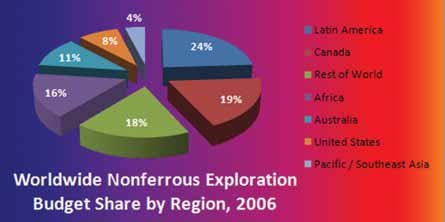 Source: Metals Economics Group, 2007
Source: Metals Economics Group, 2007
In response, PotashCorp is targeting
14.9 million mt of capacity by 2011, up
from the currently available 10.7 million
mt. According to the company, additional
debottlenecking projects in Saskatchewan
could be brought onstream by 2015, or
sooner if the market dictates, bringing total
capacity to 15.7 million mt. Announced
projects include:
• A recently announced $1.6-billion
potash mine and compaction expansion
in New Brunswick (reported elsewhere
in this issue) is the most recent of several
projects implemented to meet the
anticipated increase in world demand
for potash.
• A $346-million debottlenecking and
compaction expansion project at Lanigan,
Saskatchewan, primarily entails refurbishing
a mill that has been idle since
the mid-1980s. New mill structures and
equipment, along with upgraded mine
hoists, skips and other underground
equipment will help support higher
annual production, adding 1.5 million
mt of product, along with 750,000 mt of
additional compaction capacity. Construction
is scheduled for completion
in the second quarter of 2008.
• PotashCorp’s Patience Lake solution
mine, also in Saskatchewn, will add
300,000 mt of annual capacity via 20
new injection wells and the pumping and
piping systems required to serve them.
The project will cost an estimated $92
million, with construction scheduled to
be completed in the first quarter of 2009.
• A $775-million compaction and production
expansion and debottlenecking project
at the Cory, Saskatchewan, facility
will add another 1.2 million mt of production
capacity, with 750,000 mt of
additional compaction capacity, by mid-
2010.
• Previous debottlenecking and compaction
expansion projects have been
completed at PotashCorp’s Allan (2007)
and Rocanville (2005) facilities, both
located in Saskatchewan, at a total cost
of more than $275 million.
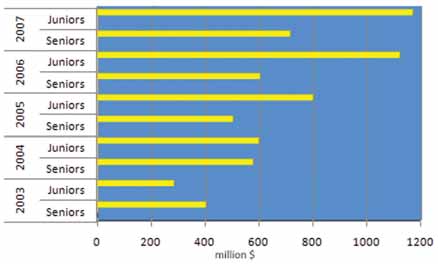 Junior companies have contributed an increasingly larger share of Canadian exploration spending.
Junior companies have contributed an increasingly larger share of Canadian exploration spending.
Exploration— The Billion-Dollar Baby
Exploration funding for Canadian projects
in 2007 is expected to continue at the $1-
billion-plus level for the fourth consecutive
year. A March 2007 federal-provincial-
territorial survey of intended exploration
spending by 734 project operators
predicted a 9% increase over 2006, representing
a total of $1.9 billion compared
with last year’s $1.7 billion and $1.3 billion
in 2005.
The survey pinned these increases primarily
on more off-minesite exploration
activity, which in 2006 represented about
75% of total spending. Off-minesite
appraisal expenditures were also a significant
factor in 2006, exceeding $300 million
for the first time since the tabulation
of these statistics began in 1997. This
trend is expected to continue as more
known deposits are being fast-tracked
toward production decisions.
Although exploration spending on precious
metals is expected to decline slightly
in 2007, intended funding for base metals,
uranium and other assorted mineral
commodities should show strong gains over
2006 levels, with uranium exploration—
encompassing more than 350 active projects—
predicted to reach a level of about
$241 million in 2007, compared with
$190 million in 2006.
The vastly expanded role of junior companies
in the minerals discovery process
becomes apparent when looking at the survey’s
figures for exploration activity split
between junior and senior companies.
Total expenditures for junior project operators
has increased from $141 million in
1999, to almost $1.2 billion in 2007.
Junior companies now account for more
than 60% of total Canadian exploration
and deposit appraisal spending.
PriceWaterhouseCoopers, in a recent
study of trends in the TSX Venture (TSX-V)
Exchange, found that junior mining companies
listed on the exchange had a total market
capitalization of $27.6 billion in
2006—an 86% increase from $14.8 billion
the previous year. The top 100 junior
mining companies had $4 billion in assets
in 2006, $2.6 billion more than in 2005.
Net financial losses among this group rose
to $395.7 million, up from $247 million in
2005, but the report attributed the increase
to the dominance of exploration-stage companies in the sector, reflecting the
current
high level of exploration activity.
All of the companies analyzed in the
report are based in Canada, with the majority
located in British Columbia. Not too
startling was the report’s revelation that 51
of the TSX-V’s top 100 companies studied
were not even in this category in 2005,
confirming the high-risk, high-reward
nature of the business and how company
values can rise and fall substantially in the
course of a year. This is also confirmed by
the fact that, from 2005 to 2006, only one
company was able to retain its ranking
among the top five on the TSX-V in terms
of market valuation. As shown in the table
above, only Northern Dynasty Minerals,
50% owner of the Pebble copper-goldmoly
deposit in southwestern Alaska following
the recently announced $1.425 billion
buy-in by Anglo American, carried over
from one year to the next.
According to the report, at the time of
publication 14 of the top 100 companies
on the TSX-V were at the production stage.
These companies accounted for:
• $3.4 billion in market capitalization
• 12% of the total industry market capitalization
of the industry; and
• 23% of the top 100 market capitalization.
One-third of the top 100 production
and exploration companies on the TSX-V
operate in Canada, followed by the U.S.
(14%) and Mexico (12%). Altogether,
17% operate in South American countries.
In 2006, TSX-V mining companies
spent $409.4 million on mineral properties
and exploration, along with another
$103.9 million on plant and equipment
costs. But perhaps the most impressive
number, according to the PriceWaterhouse-
Coopers report, is the $1.2 billion that
exploration companies were able to raise
through issuing shares during 2006, a
206% gain over 2005.
Juniors Fitting In
Almost by definition as well as by necessity,
the more successful junior mining companies
are staffed “lean and mean,” mostly
with experienced geologists and engineers,
and are generally led by entrepreneurially
aggressive executives. The flexibility
and willingness to take risks afforded
by juniors make them a perfect fit for a
business environment in which industry
consolidation has resulted in fewer but
larger senior companies with scaled-back
exploration staffs and constant pressure to
replenish mineral reserves.
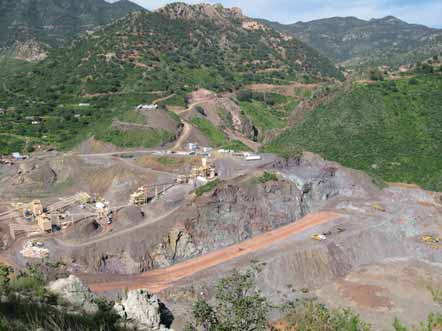 Aerial view of current activity at Minefinders Corp.ís Dolores gold-silver project in Mexico.
Aerial view of current activity at Minefinders Corp.ís Dolores gold-silver project in Mexico.
However, even nimble juniors can be
affected by broad industry trends and problems
such as lack of manpower, time pressure
to bring promising finds to marketable
status, and even long lead times for vital
equipment delivery among juniors intent
upon taking their own projects to the development
and production phases.
In order to gauge the effect of these
factors, E&MJ spoke with the CEOs of two
Canadian companies that presently are on
almost opposite ends of the project development
timeline—one is nearing the start
of production at its flagship project while
the other is heavily involved in exploration
drilling to delineate the extent of mineralization
at properties in Canada and Mexico.
We also talked with the chief executives of
two well-known engineering firms to find
out if, and how, the mining boom and its
associated demands for time and resources
have affected the way in which their companies
conduct business.
Minefinders Corp. is a Vancouver,
British Columbia-based junior with a portfolio
of properties in Mexico and the United
States. Its primary focus currently is on the
impending startup of its Dolores open-pit
gold and silver mine in Chihuahua, Mexico,
which is scheduled to begin operations this
month and to reach commercial production
in the second quarter of 2008. Located in
a historical mining district, early operations
at Dolores were reported in E&MJ early in
the 1900s.
The reserve base at Dolores currently
stands at 2.45 million oz of gold and
127.9 million oz of silver. The reserves,
which were updated in July 2006, are contained
in 100.2 million mt of proven and
probable ore having an average diluted
grade of 0.76 g/mt gold and 39.7 g/mt silver,
using a 0.3-g/mt AuEq cutoff. An
updated resource was reported in June
2007, with Measured and Indicated now
standing at 123.4 million mt containing 3.25 million oz of gold averaging 0.82
g/mt and 154.8 million oz of silver averaging
39 g/mt. A revised pit design is being
completed and updated reserves should be
reported before year end.
Minefinders has done more than
200,000 m of drilling at the site, sinking
more than a 1,000 drillholes. The deposit
will be mined by open-pit methods for 14
years of production, with development of
an underground mine beneath the pit
expected to begin in about three years. The
facilities are designed for production of
18,000 t/d of ore; open-pit mine life will
be 14 years. Output is expected to average
120,000–130,000 oz/y of gold and 4.5
million oz/y silver.
Engineering design work has been
farmed out to a number of firms, including
Golder Associates for leach pad and geotechnical
requirements; Terra Nova
Industries for the crushing and stacking
systems; Lyntek for the mine’s Merrill-
Crowe plant and smelter; and Ausenco for
ancillary systems and tie-in for overall engineering.
Once commercial production is
achieved through the heap-leach and
Merrill Crowe plant facilities, Minefinders
intends to build a mill to handle higher
grade ore from the pit.
“Our original study looked at installation
of the heap leach and the mill at the
start of the mine, but that would have cost
more than $270 million,” Minefinders
President and CEO Mark Bailey said. “We
weren’t going to be able to raise that much
money for our first mine, however.”
Bailey, who has been associated with
the company since 1994, said the biggest
challenge in the critical path of the construction
so far has been timely completion
of earthworks in the mountainous host terrain.
Earthworks for the phase-one leach
pad took longer than expected, because of
higher volumes of material than those estimated
in the feasibility study, the need for
additional blasting, and slow progress during
an unusually wet monsoon season in
July. However, a section of the phase-one
pad will be available for lining in
September and loading in late October, in
conjunction with the commissioning of the
three-stage crushing plant. The village of
Dolores is situated on a portion of the property
to be mined and the company is in the
process of relocating the residents to new
homes built about 5 km away.
Bailey identifies the largest problem
faced by his company—and the industry as
a whole—as being able to find qualified
people. “There are a number of factors
involved,” said Bailey. “We had to look far
and wide to assemble our operational
team, and I know of other operators who
have had to pull guys out of retirement
because there simply wasn’t anyone else
available.
“Engineering and service firms are in
the same boat. They’re overwhelmed by the
amount of work that’s out there, and
they’re having trouble finding good people,
too. During the down-market years in the
1980s and 1990s, a lot of young engineers
and geologists had to look elsewhere
for jobs, and now we’re missing a whole
generation of engineers. Most of our guys
have 20 or 30 years in the industry, but it’s
very hard to find young engineers with any
mining experience.
“Looking forward,” said Bailey, “I don’t
see the high current demand for commodities
changing any time soon. This is good
for juniors and for the industry as a whole,
but it will put tremendous strain on [mining]
resources.”
According to Bailey, another factor that
weighs heavily on junior miners is compliance
with the requirements of the Sarbanes-
Oxley Act of 2002, the U.S. federal law that
expanded financial reporting regulations for public companies and accounting firms.
“As
a junior company, we have essentially the
same reporting requirements as a $60-billion
company, but we don’t have a big staff
of lawyers and accountants to handle the
work,” he said. “We’re spending a tremendous
amount of money on outside auditing
and legal work to comply with the law, and
that’s money that we can’t use to go out and
explore for minerals, which is what we do
best. I don’t think you can legislate honesty
and morality into law. They need to take
another look at Sarbanes-Oxley and try to
make it ‘saner’ for small businesses.”
Bailey doesn’t view new technology as a
major near-term benefit for exploration
companies. “We’ve made our discoveries
by putting geologists on the ground, beating
on rocks. That’s the way it’s been done
for hundreds of years, and I don’t see any
magic black box that’s going to give better
results than an experienced geologist working
in the field.”
Nor does Grant Ewing, president of
Linear Metals Corp., Toronto, Ontario, a
junior company focused on exploration for
base metals and molybdenum. Linear currently
has two “core” projects: the
Kilometer 61 porphyry-type molybdenumcopper
property in Ontario and the Cobre
Grande copper-molybdenum-zinc-silver
skarn deposit in Oaxaca State, deep in
southern Mexico. Linear is in the early
stages of drilling at both properties, collecting
data needed to conduct initial
resource evaluations during 2008.
Linear’s exploration staff includes several
senior-level geologists with years of prior
service at large Canadian base metals producers,
but Ewing is very aware of the
industry’s manpower problems. “It’s very
difficult to find experienced geologists
these days to expand a technical staff. I’m
sure that any good geologist who wants to
work already has a job.” And he doesn’t see
any technology on the horizon that will
replace field experience. “We’ll consider
any geophysical or geochemical method
that would help us explore the ground we
hold, of course, but we depend primarily on
the experience of our exploration team to
develop our exploration programs.”
Linear recently announced encouraging
results at the KM61 site, where it was able
to evaluate samples from a core drilling
program conducted by Noranda and
Falconbridge when the property was
optioned in 2004-2005. Much of the drill
core generated during those programs was
left unsampled because the companies
were targeting copper mineralization.
Results from Linear’s analysis of the
unsampled core included 143.2 m of
0.068% Mo, 0.14% Cu and 6.1 g/mt Ag;
and 193.6 m of 0.052% Mo, 0.11% Cu
and 7.1 g/mt Ag. “These results indicate
that what was previously thought to be two
distinct, and relatively narrow zones, may
instead be one broad stockwork zone. This
increased total width of mineralization has
clearly increased the size potential of
KM61 at grades that appear comparable to
that of other large molybdenum projects
currently under development,” Ewing said.
The Cobre Grande property also has
produced some impressive core samples,
including 130 m of 1.62% copper, 0.51%
zinc, 0.01% molybdenum, and 29 g/mt
silver starting at 48 m; and 7 m of 0.91%
copper, 0.05% zinc, 0.01% molybdenum,
and 19.14 g/mt silver, beginning at 188
m. For a company at Linear’s stage of
prospect development, dependable drilling
service is a critical factor. “There’s certainly
a difference between drilling contractors
in terms of production rate, and I’d attribute
that difference mostly to quality of
manpower and equipment. Contractors Ateams,—
the crews that consistently produce
large quantities of core with good recoveries—are in extremely high demand
by mining companies,” said Ewing.
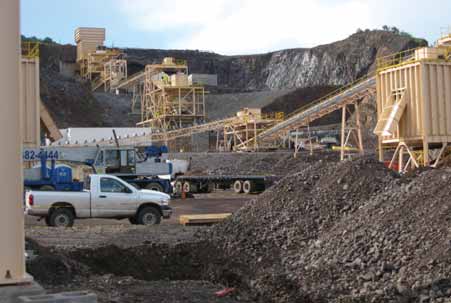 Installation of a three-stage crushing facility at Minefindersí Dolores project is progressing
Installation of a three-stage crushing facility at Minefindersí Dolores project is progressing
on schedule to handle
startup of mining in September and commencement of production in
the second quarter of 2008.
Engineering Meets the Rush to Development
On the flip side of the coin, the consulting
engineering and design firms that provide
critical preliminary assessments, bankable
feasibility studies and various other projectrelated
assignments for both junior and
senior companies also are affected by
boom-linked issues. Andy Barrett, group
CEO and president of North American practice
for SRK Consulting, said that in today’s
robust business environment competition
between firms has shifted more toward a
hunt for skilled, experienced people and
away from skirmishing with each other for
actual work. Along with that trend, Barrett
notes that higher salaries for experienced
mining specialists and a drift toward more
sole-source work and fewer competitive-bid
opportunities are also part of the boom’s
good-news/bad news package.
SRK—whose client list ranges from
CVRD, Centerra Gold and DeBeers to iron
ore producer MMX, NovaGold, Teck
Cominco and includes many others—has
been in the somewhat painful position,
along with other major firms in its sector, of
having to decline or delay requests for work
because of the overall volume of activity
and shortage of experienced people. Along
with that, notes Barrett, comes a higher
degree of selectivity in accepting projects
and much greater emphasis on human
resource management.
“In this business,” explained Barrett,
“you’re only as good as the people you have
on the ground, and we realize that our
competitors are looking for the same kind
of people that we are. This has resulted in
upward pressure on salaries and has
required us to search farther afield to find
the people that we need.
“From the start of this boom we’ve also
recognized that we need to be very careful
to manage the quality aspects of our
work,” Said Barrett. “With the current
high volume of work we’re experiencing,
we can’t afford to allow things to slip, and
we’ve ratcheted up our formal review procedures
accordingly, to prevent the kind of
mistakes that can happen when people are
working long, hard hours.”
When asked how the mining boom has
affected the type, locale, makeup or focus
of SRK’s overall mining project portfolio,
Barrett quickly ticked off several distinct
trends. These include:
• Re-opening of old projects (gold and
base metals) with hopes of getting them
back into production.
• Increased demand for NI 43-101 reports
that allow companies to announce results
from new properties/projects and raise
money, or to get listed on the stock
exchange.
• Increased confidential due diligence
reviews for acquisitions and assistance
with defense against hostile takeovers.
• Increased assistance to foreign companies
seeking Canadian listings.
• Increased involvement in existing operations
to fill technical skills gaps.
• Substantially more uranium work.
• Projects in Brazil, China and Russia/FSU
becoming increasingly prominent.
• Emergence of private equity firms in the
sector.
Vancouver, B.C.-based Wardrop Engineering
has been in business since 1955
and has been serving mining clients since
the early 1960s. It offers a full range of
services including project scoping, pre-feasibility
and feasibility studies, EPCM and
ongoing technical support. Recent project
involvement includes EPCM services for
Baja Mining Corp.’s Boleo copper-cobalt
project in Baja California Sur, Mexico; and engineering and procurement for Redcorp
Ventures’ Tulsequah polymetallic project in
British Columbia. Wardrop also conducted
the feasibility study for the Tulsequah project.
Other work ranges from resource evaluations
for Western Copper Corp.’s
Carmacks copper project and an optimized
feasibility study for development of Yukon
Zinc Corp.’s Wolverine underground mine;
to various assignments for Teck Cominco,
Xstrata, CVRD Inco and Cameco.
Brent Thompson, president of Wardrop,
said the industry’s rush to get mineral assets
into development, coupled with manpower,
materials and equipment shortages, adds
another degree of pressure to the scheduling
process. “For many of these projects now
nearing the construction phase, availability
of the required materials and equipment is
constrained. When it comes to doing capital
cost estimates and construction scheduling,
we have to keep very close tabs on equipment
lead times. In fact, we now tend to fasttrack
the longer lead-time items. When we
perform EPCM services for project development
we’ll actually start working on the engineering
and procurement for long-lead items
as we complete the feasibility study. It’s the
only way to make sure we can keep projects
moving forward in a logical fashion.”
However, Thompson noted that his
biggest challenge at the moment is effectively
managing and maintaining the company’s
talent pool—and he envisages future
consequences for mining that might not
become apparent until the current boom
runs its course. “The mining industry’s
demographics are working against it,” he
said. “Older professionals with 30 or more
years in the industry will be retiring in five
years or so. I think there are enough experienced
workers around now to get us through
this boom, but when it eventually tails off
and then picks up again in the future, the
mining industry is going to be very different
from the way it is today. It’s likely there won’t
be a lot of people around with the experience
needed to move projects forward.”
